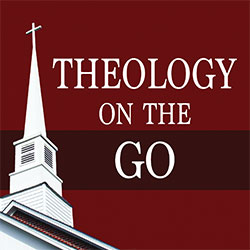
Francis Gomarus and the Synod of Dordt
Tempers ran high at the Synod of Dordt. By January 1619, Francis Gomarus, Reformed minister and veteran professor at the University of Leiden, had come to take some Remostrants’ opinions on the extent of Christ’s atoning sacrifice as a personal offense.
“Ego hanc rem in me recipio” (“I take this charge to myself”), he cried as he rose to his feet in response to a comment by his German colleague Matthias Martinius. Dropping his glove, he pronounced a proverbial exhortation to bravery, “Ecce Rhodum, ecce saltum” (basically, “Take a leap, no matter how far is land”).
As it turned out, Martinius didn’t take up the challenge, not even when Gomarus repeated it at the close of the day’s meeting. Apparently, no one got hurt. Gomarus’s response, however, is a clear indication of the seriousness of the matter at hand.
Student and Teacher
Gomarus was born in Bruges (in today’s Belgium) in 1563, which was at that time in the Flemish region of the Low Countries (Netherlands). It was a period of great unrest, with the increasing influence of the Protestant Reformation in the country and the stern reaction of the Spanish ruler, Philip II. Gomarus’s family, one of the many to turn Protestant, had to flee to the Electorate of the Palatinate, Germany.
Gomarus was a bright young man. At 14, he already knew enough Latin and Greek to enter the University of Strasbourg. From there, he moved to Neustadt, where he studied theology under Zachary Ursinus, Girolamo Zanchi, and Daniel Tossanus, three men who deeply shaped his biblical understanding.
He later studied at Oxford, Cambridge, and Heidelberg, until he was called to serve as pastor of the refugee Flemish church in Frankfurt. He remained there until 1593, when a wave of persecution forced the church to disperse. The next year, he was appointed professor of theology at the University of Leiden.
The University of Leiden (the first in the Netherlands) was built in 1575 when William, Prince of Orange and leader of the Dutch revolt against the Spanish, decided to reward the city for its stalwart resistance during the war. Apparently, he gave the citizens of Leiden a choice between a university and relief from taxes during the city’s annual fair, and they chose the first.
By the time Gomarus arrived, the university was already benefiting from the teaching of esteemed professors. Gomarus, who had been deepening his understanding of the Reformed faith since his days at Neustadt, found himself in a congenial place.
The Clash with Arminius
As in every institution, some teachers left or died and others took their place. When, in 1603, 37-year old Leiden alumnus Jacobus Arminius was proposed as replacement for two professors who had died of the plague, Gomarus cautiously welcomed him. Other teachers were opposed to this choice because Arminius had already shown some unorthodox tendencies, particularly in his interpretation of Paul’s Epistle to the Romans. On the other hand, he had in the past received recommendations by Theodore Beza, the French theologian who had taken John Calvin’s place in Geneva.
Soon, however, Gomarus became aware of some teachings by Arminius which seemed dangerously close to Pelagianism – the ancient heresy that taught that human beings have, in themselves, the power to cooperate with God’s grace in salvation. Arminius denied the charges. When the same accusations were repeated in an anonymous series of thirty-one articles, he asked the States of Holland for a chance to explain himself. The States agreed.
Arminius and Gomarus had two chances to deliver speeches before the Supreme Court at La Hague, Netherlands. In the end, however, the Court ruled that the differences between the two were minor. Unconvinced, the two professors continued to publish and circulate their speeches.
Arminius died on October 19, 1609, but the controversy lived on. Less than three months after Arminius’s death, 48 followers of Arminius met at La Hague and composed a list of objections to orthodox Reformed teaching. They called their document Five Articles of Remonstrance. Their ideas found more supporters, in spite of contrasting documents produced by Reformed authors.
At the same time, the University of Leiden replaced Arminius with one of his sympathizers, Conradus Vorstius, who had already been accused of false teachings about the Trinity and Christ’s atonement. Frustrated by the university environment and by the government’s ambiguity (they insisted on holding the final ruling but refused to take the matter seriously), Gomarus resigned from Leiden and resumed his pastoral ministry at Middelburg, Netherlands. In 1614, he was called to teach at the Academy of Saumur, France, and stayed there until 1618, when he accepted a call as professor of theology and Hebrew at the University of Groningen, in the northern Netherlands.
In each of his new posts, Gomarus continued to alert the nation of the dangers of the Arminian teachings, which was bringing the nation to the verge of religious schism and civil war. It was not, as the courts had so unperceptively spurned, a squabble on theological technicalities. To Gomarus and others likeminded Christians, the very heart of the Reformation – the doctrine of justification by faith alone – was at stake.
Gomarus at Dordt
The disagreements between Arminians and Reformed became so sharp that the necessity for a synod of church leaders was apparent. In the Netherlands, however, this could not happen without the government’s permission, and Jovan Van Oldenbarneveldt, the most influential leader in a republic with no central government, was an Arminian sympathizer.
All this changed suddenly when Maurice of Nassau, second son of William of Orange, denounced Oldenbarneveldt as traitor because of a political treaty with Spain. Eventually, Maurice had Oldenbarneveldt arrested, convicted, and executed, and became the most influential leader in the Netherlands. Since Maurice supported the Reformed, he allowed the convening of the synod of churches.
Immediately, the Dutch Reformed organized the meeting, inviting representatives from other European countries (since the controversy had spread outside the Netherlands). Everyone accepted the invitation except for the representatives from France, who had been prevented by King Louis XIII (they could leave, he said, but wouldn’t be able to return). It was the first international synod in the history of the Reformed church.
The Remostrants didn’t take the decision lying down, but organized riots to oppose it. The protests calmed down only when Maurice marched into Utrecht (an Arminian city) with his troops.
Finally, the Synod assembled at Dordt (or Dordrecht), in the southern Netherlands, on November 13, 1618. Gomarus attended as representative of the University of Groningen and – as the challenge to duel illustrates – expressed his convictions with extreme urgency and passion.
The Arminian controversy can be summarized as a matter of salvation. The Arminians believed that God elects to eternal life those he foresees will respond by faith. The problem for Gomarus and others is that this makes faith the basis and condition of God’s election (rather than a sovereign and unconditional gift of God). It was a teaching that Protestant Reformers such as Martin Luther would have absolutely rejected. To allow it in the churches meant, for Gomarus, forsaking and betraying the Reformation.
The Synod concluded in May 2019, after producing a clear document (known as the Canons of Dordt) which has endured through the centuries as normative for Reformed churches. The answers to the Five Remonstrances have often been abbreviated in what are called “Five Points of Calvinism.” In reality, they were specific answers to specific questions. The document was written in a popular language, to be read and understood by all.
After the Synod, Gomarus returned to his position at Groningen, where he kept busy teaching, writing, and working on an official translation of the Old Testament in Dutch. He died on January 11, 1641.

























